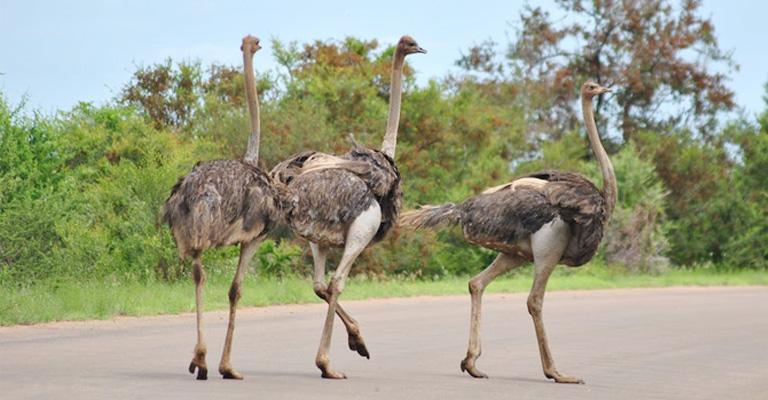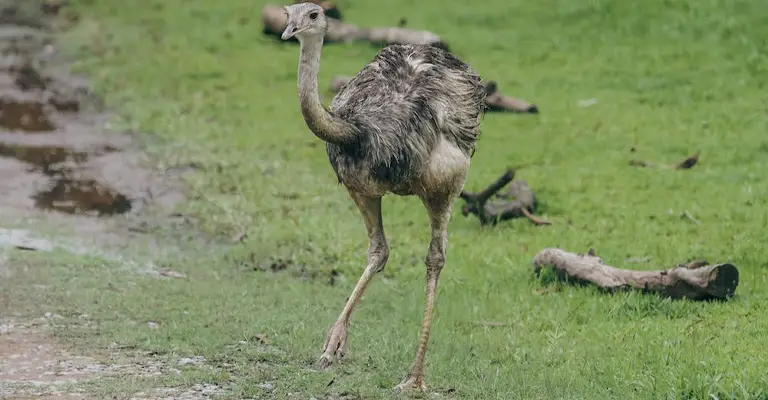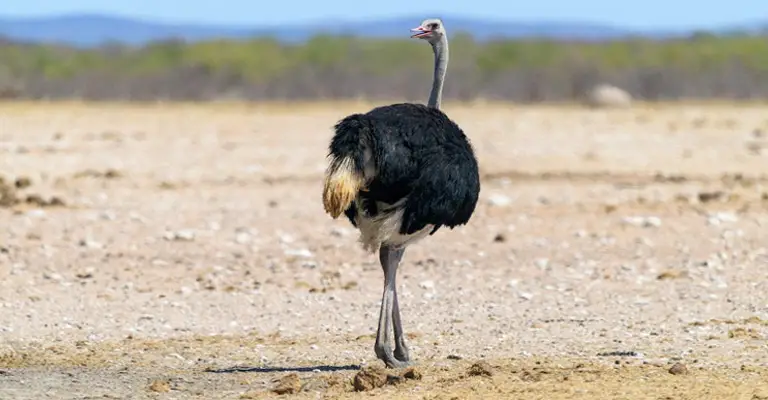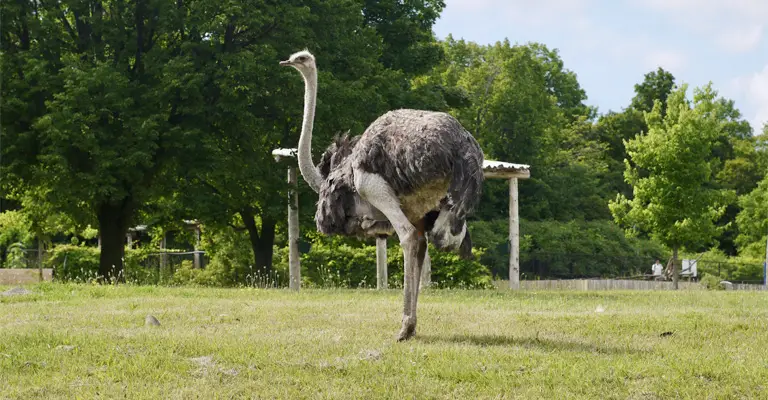Ostriches, the largest living bird species, have long been admired for their physical prowess, but their intelligence remains a subject of intrigue.
In this article, we delve into how intelligent are ostriches, seeking to understand the cognitive abilities of these remarkable creatures.
While they may not possess the problem-solving skills of some highly intelligent animals, ostriches exhibit a range of behaviors that suggest a level of intelligence adapted to their unique environment.
We explore their social dynamics, communication methods, and ability to navigate their surroundings. By unraveling the intricacies of ostrich intelligence, we gain a deeper appreciation for their adaptive capabilities and the evolutionary factors that have shaped their cognitive abilities.
Join us on this journey as we uncover the fascinating world of ostrich intelligence and challenge preconceived notions about the limits of avian intellect.

How Intelligent Are Ostriches?
Ostriches, the largest living bird species, possess a level of intelligence that is adapted to their unique environment.
While they may not exhibit the same problem-solving abilities as some highly intelligent animals, they display a range of cognitive behaviors that highlight their adaptive intelligence.
Social Dynamics and Communication
Ostriches are social animals that live in groups called flocks. They exhibit complex social dynamics, with individuals forming hierarchies and engaging in cooperative behaviors.
This suggests a level of social intelligence and the ability to navigate complex social relationships within their flocks.
Communication among ostriches involves a variety of vocalizations, body postures, and displays. They use different calls to communicate alarm, courtship, and territorial defense.
This ability to communicate effectively within their social group demonstrates a level of cognitive sophistication.
Environmental Adaptation
Ostriches have evolved to survive in challenging environments, such as arid and open grasslands. Their intelligence is evident in their ability to navigate and adapt to these habitats.
They possess excellent eyesight, allowing them to detect predators from a distance and make quick decisions to ensure their safety.
Problem-Solving Skills

While ostriches may not exhibit the same problem-solving abilities as some highly intelligent animals, they do display some level of cognitive flexibility.
For example, they can learn to recognize and remember specific landmarks or locations within their environment. This skill helps them navigate and find resources in their vast habitats.
Learning and Memory
Ostriches have demonstrated the ability to learn and remember information. They can remember the locations of food sources, waterholes, and nesting sites.
This suggests a level of cognitive ability that allows them to adapt their behavior based on past experiences.
Cognitive Flexibility
Ostriches have also shown cognitive flexibility in certain situations. For example, when faced with a barrier or obstacle, they have been observed using their beaks and feet to manipulate objects or find alternative routes.
This ability to assess and overcome obstacles demonstrates a level of cognitive flexibility and problem-solving intelligence.
Ability to Learn
Ostriches have demonstrated the ability to learn and remember information. They can recognize familiar individuals within their flock and remember social relationships.
Additionally, they can learn from past experiences and adjust their behavior accordingly. For example, if an ostrich encounters a predator in a specific area, it may avoid that area in the future, indicating a form of spatial memory and learning.
Parental Care and Nesting Behavior
Ostriches exhibit complex nesting behavior and parental care, which requires a certain level of intelligence. Female ostriches carefully select and prepare their nests, taking into account factors such as temperature, camouflage, and accessibility.
They also engage in cooperative incubation, with males taking turns to sit on the eggs and regulate their temperature. This cooperative behavior and the ability to care for their offspring demonstrate a level of intelligence and parental investment.
While ostriches may not possess the same level of intelligence as some highly intelligent animals, they exhibit a range of cognitive behaviors that highlight their adaptive intelligence.
From their social dynamics and communication skills to their problem-solving abilities, learning and memory, and parental care, ostriches showcase a level of intelligence that is well-suited to their environment.
How Are Ostriches So Fast?

Ostriches are renowned for their incredible speed, making them the fastest-running birds and land animals. Several factors contribute to their remarkable speed:
Leg Structure
Ostriches have long, powerful legs that are perfectly adapted for running. Their legs are designed to generate strong propulsion and cover large distances with each stride.
The length and strength of their legs allow them to take long strides, maximizing their speed.
Muscularity
Ostriches have well-developed leg muscles, particularly in their thighs and lower legs. These muscles provide the necessary power and force for rapid acceleration and sustained running.
The combination of strong leg muscles and efficient energy transfer enables them to achieve high speeds.
Stride Length
Ostriches have an impressive stride length, often reaching up to 10 to 16 feet (3 to 5 meters) per stride.
Their long legs and flexible joints allow for extended strides, covering more ground with each step. This elongated stride length contributes to their overall speed.
Balance and Stability
Ostriches have excellent balance and stability, which are crucial for maintaining their speed.
Their bodies are well-balanced, and they have a strong core that helps them maintain stability while running at high speeds. This allows them to make quick turns or changes in direction without losing momentum.
Aerodynamics
Ostriches have streamlined bodies and aerodynamic feathers that reduce air resistance while running. Their wings, although not used for flight, help with balance and stability by acting as stabilizers during high-speed running.
Energy Efficiency
Ostriches have evolved to be highly energy-efficient runners. They have a unique double-spring mechanism in their legs, where tendons store and release energy with each stride.
This energy-saving mechanism allows them to maintain their speed over long distances without excessive fatigue.
Ostriches’ impressive speed can be attributed to their leg structure, muscularity, stride length, balance, aerodynamics, and energy-efficient running mechanisms.
These adaptations have allowed them to become the fastest-running birds and excel in their natural habitats.
Why Are Ostriches Important?

Ostriches play an important role in their ecosystems and have significance in various aspects:
Biodiversity
Ostriches contribute to the overall biodiversity of their habitats. As keystone species, they have a significant impact on the ecosystem by influencing the abundance and distribution of other species.
Their presence helps maintain the balance of the ecosystem and supports the diversity of plant and animal life.
Seed Dispersal
Ostriches consume a variety of plant materials, including fruits and seeds. As they move through their habitats and digest these plant materials, they inadvertently disperse seeds in their droppings.
This seed dispersal mechanism helps in the regeneration and spread of plant species, contributing to the overall health and diversity of vegetation.
Nutrient Cycling
Ostriches play a role in nutrient cycling within their ecosystems. Their droppings, rich in organic matter, provide valuable nutrients to the soil. This nutrient input enhances soil fertility and supports the growth of plants, benefiting the entire ecosystem.
Tourism and Conservation
Ostriches are charismatic and iconic animals, attracting tourists and nature enthusiasts. Their presence in wildlife reserves and protected areas contributes to ecotourism.
It generates revenue for local communities and supports conservation efforts. By conserving ostrich habitats, we also protect other species and maintain the ecological integrity of these areas.
Cultural and Economic Importance
Ostriches have cultural significance in various societies and have been part of human history for centuries. They have been a source of food, feathers, and other materials used in traditional crafts.
In some regions, ostrich farming and the production of ostrich-related products, such as meat, leather, and feathers, contribute to local economies and livelihoods.
Research and Education
Studying ostriches provides valuable insights into avian biology, behavior, and evolution.
Research on ostriches helps expand our understanding of animal physiology, locomotion, and adaptation to extreme environments.
Additionally, ostriches serve as educational ambassadors, helping raise awareness about the importance of wildlife conservation and the need to protect their habitats.
Overall, ostriches are important for maintaining biodiversity, seed dispersal, nutrient cycling, tourism, cultural heritage, research, and education.
Recognizing their ecological significance and conserving their habitats is crucial for the overall health and sustainability of ecosystems and the well-being of both human and animal communities.
FAQs
No, ostriches are not considered endangered. They are classified as a species of “Least Concern” by the International Union for Conservation of Nature (IUCN).
However, local populations in certain regions may face threats due to habitat loss, hunting, and illegal trade.
In the wild, ostriches have an average lifespan of 30 to 40 years. However, in captivity, they can live even longer, with some individuals reaching up to 50 or 60 years of age.
No, ostriches are flightless birds. They have large, powerful legs that are adapted for running, but their wings are not designed for flight. However, ostriches can use their wings for balance and display during courtship rituals.
Female ostriches lay large eggs, typically weighing around 3 to 5 pounds (1.4 to 2.3 kilograms).
They usually lay a clutch of 10 to 12 eggs, but larger clutches of up to 60 eggs have been recorded. The eggs are incubated by both male and female ostriches.
While ostriches are not natural swimmers, they are capable of crossing shallow bodies of water by wading or floating.
Their buoyant bodies and strong legs allow them to navigate through water, but they are not adapted for long-distance swimming.
Final Thoughts
Ostriches may not possess the same level of intelligence as some other highly intelligent animals, but they exhibit a range of cognitive abilities that are uniquely adapted to their environment.
From their social dynamics and communication methods to their ability to navigate their surroundings, ostriches showcase a remarkable intelligence that allows them to thrive in their habitats.
While further research is needed to fully understand the extent of their cognitive capabilities, studying ostrich intelligence provides valuable insights into the diverse ways in which animals adapt and interact with their surroundings.
By appreciating the intelligence of ostriches, we gain a deeper understanding of the intricate web of life and the remarkable diversity of cognitive abilities found in the animal kingdom.
So, let us continue to unravel the mysteries of ostrich intelligence and celebrate the fascinating world of these magnificent birds.